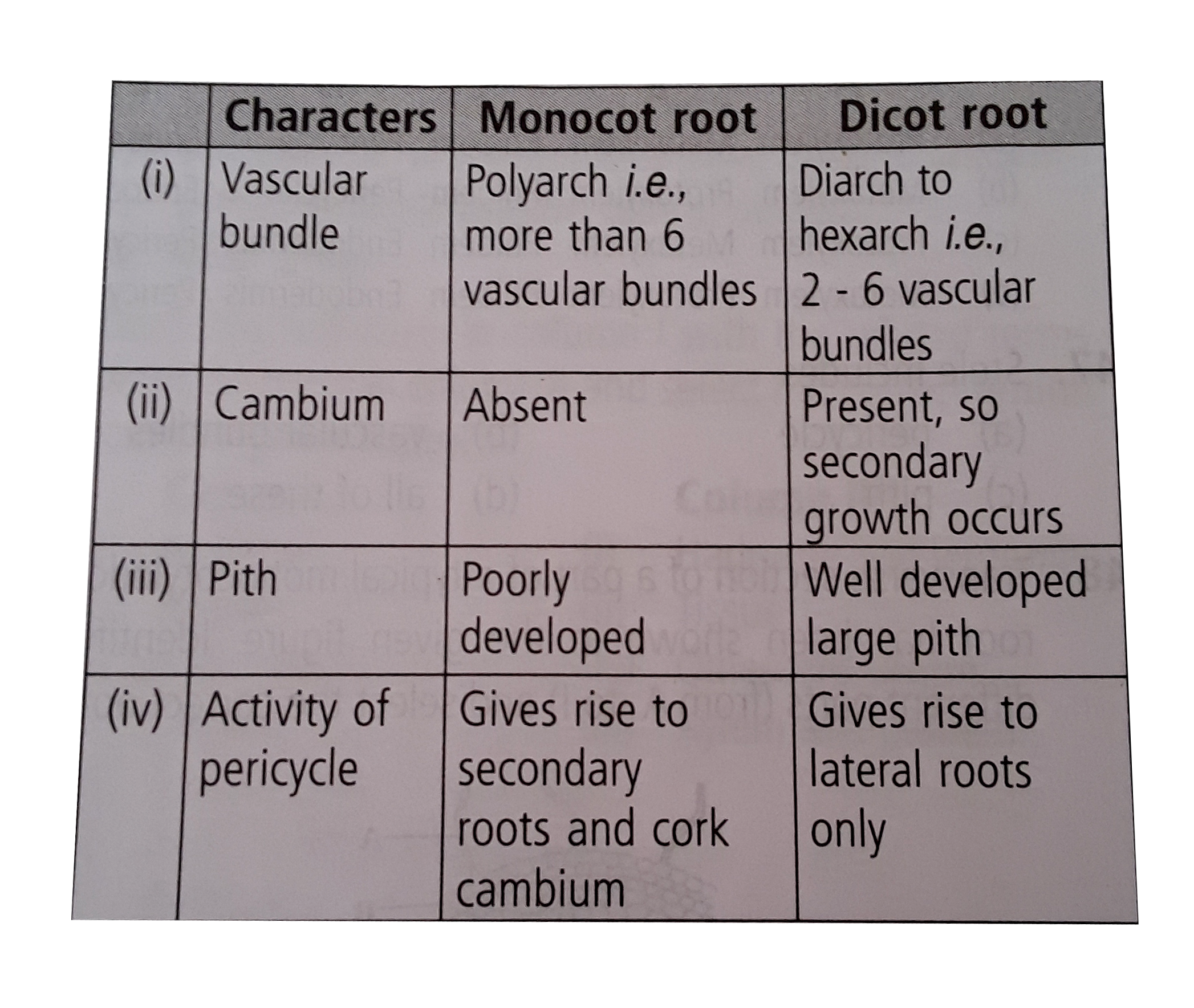Monocot root differs from dicot root in having
More than six xylem bundles
Pericycle
Endodermis
Showing secondary growth
The correct Answer is:A
To answer the question regarding how monocot roots differ from dicot roots, we will analyze the structural differences between the two types of roots.
1. Vascular Bundle Arrangement:
- In dicot roots, the vascular bundles are arranged in a diarch pattern. This means there are two xylem poles.
- In monocot roots, the vascular bundles are arranged in a polyarch pattern, which means there are multiple xylem poles.
Hint: Remember that "diarch" refers to two and "polyarch" refers to many.
2. Pith Size:
- The pith in dicot roots is usually small.
- In monocot roots, the pith is relatively large.
Hint: Think about the space available in the center of the root; monocots have more room.
3. Cortex and Chenileum:
- In dicot roots, the chenileum (conjunctive tissue) can become meristematic, allowing for secondary growth.
- In monocot roots, the chenileum does not become meristematic, which means there is no secondary growth.
Hint: Secondary growth is crucial for thickening; consider which type of root can grow thicker over time.
4. Pericycle Function:
- In dicot roots, the pericycle can give rise to cork and lateral branches.
- In monocot roots, the pericycle primarily gives rise to only lateral branches.
Hint: Think about the additional structures that can develop from the pericycle in dicots.
5. Secondary Growth:
- Dicot roots exhibit secondary growth, which allows them to increase in thickness over time.
- Monocot roots typically do not show secondary growth.
Hint: Secondary growth is a key feature of dicots; consider how this affects the overall structure of the plant.
Conclusion:
Monocot roots differ from dicot roots primarily in their vascular bundle arrangement (polyarch vs. diarch), the size of the pith (large vs. small), the behavior of the chenileum (no secondary growth vs. meristematic), the function of the pericycle (only lateral branches vs. cork and lateral branches), and the presence of secondary growth (absent in monocots).
Final Answer:
Monocot roots differ from dicot roots in having a polyarch arrangement of vascular bundles, a larger pith, a non-meristematic chenileum, and the absence of secondary growth.
- In dicot roots, the vascular bundles are arranged in a diarch pattern. This means there are two xylem poles.
- In monocot roots, the vascular bundles are arranged in a polyarch pattern, which means there are multiple xylem poles.
- The pith in dicot roots is usually small.
- In monocot roots, the pith is relatively large.
- In dicot roots, the chenileum (conjunctive tissue) can become meristematic, allowing for secondary growth.
- In monocot roots, the chenileum does not become meristematic, which means there is no secondary growth.
- In dicot roots, the pericycle can give rise to cork and lateral branches.
- In monocot roots, the pericycle primarily gives rise to only lateral branches.
- Dicot roots exhibit secondary growth, which allows them to increase in thickness over time.
- Monocot roots typically do not show secondary growth.
Monocot roots differ from dicot roots primarily in their vascular bundle arrangement (polyarch vs. diarch), the size of the pith (large vs. small), the behavior of the chenileum (no secondary growth vs. meristematic), the function of the pericycle (only lateral branches vs. cork and lateral branches), and the presence of secondary growth (absent in monocots).
Monocot roots differ from dicot roots in having a polyarch arrangement of vascular bundles, a larger pith, a non-meristematic chenileum, and the absence of secondary growth.
Topper's Solved these Questions
- BOOK - AAKASH SERIESCHAPTER - HISTOLOGY AND ANATOMY OF FLOWERING PLANTSEXERCISE - EXERCISE - I (SECONDARY GROWTH)45videos
HISTOLOGY AND ANATOMY OF FLOWERING PLANTS
- BOOK - AAKASH SERIESCHAPTER - HISTOLOGY AND ANATOMY OF FLOWERING PLANTSEXERCISE - EXERCISE - II214videos
HISTOLOGY AND ANATOMY OF FLOWERING PLANTS
- BOOK - AAKASH SERIESCHAPTER - HISTOLOGY AND ANATOMY OF FLOWERING PLANTSEXERCISE - EXERCISE - I (THE TISSUES SYSTEMS)41videos
HISTOLOGY AND ANATOMY OF FLOWERING PLANTS
- BOOK - AAKASH SERIESCHAPTER - ENVIRONMENTAL ISSUESEXERCISE - Exercise-III (Previous AIPMT/NEET Questions)41videos
ENVIRONMENTAL ISSUES
- BOOK - AAKASH SERIESCHAPTER - HUMAN HEALTH DISEASEEXERCISE - EXERCISE - III (PREVIOUS AIPMT/NEET QUESTIONS)56videos
HUMAN HEALTH DISEASE
Similar Questions
Knowledge Check
- Question 1 - Select One

Following table summarises the differences between a monocot root and a dicot root. Identify the incorrect differences and select the correct optionA(i) and (iii)B(i) and (iv)C(iii) and (iv)D(ii) and (iii)
Monocot root has
View SolutionA dicot root differs from a monocot root in which of the following -
View SolutionStilt roots differ from prop roots in
View SolutionRhizome differs from root in
View SolutionIn a dicot root
View SolutionRoot differs from stem in having
View SolutionState true or false. Monocot stem differs from dicot stem.
View Solution

